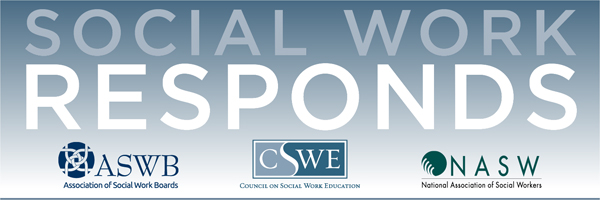Published on : October 23, 2020

About Social Work Responds
The Association of Social Work Boards (ASWB), the Council on Social Work Education (CSWE), and the National Association of Social Workers (NASW) are committed to collaborating on the range of issues affecting the social work profession and the people and communities we serve.
Follow-Up
Hundreds of social work research and education presentations during CSWE’s Annual Program Meeting (APM) will have a common theme: Leading Critical Conversations on Diversity, Equity, & Inclusion.(Opens in a new window) Register today for this year’s virtual meeting and access hundreds of live and prerecorded presentations or attend daily keynote sessions, including a conversation on antiracism with Professor Ibram X. Kendi. See this year’s schedule at a glance(Opens in a new window) and register for the 2020 APM.
ASWB is seeking qualified social workers to write questions for the licensing exams used in the United States and Canada. Writers are selected for their social work expertise and balanced to reflect diversity in practice area, geography, and demographics. Deadline for applications is December 31, 2020. Learn more and apply(Opens in a new window).
How Do You Eat an Elephant?
As cases of COVID-19 continue to increase, our nation is facing many enormous challenges. Safeguarding our mental and physical health can be a catch-22. To slow the spread of the virus, we are asked to physically isolate ourselves from society. Even recovering from COVID-19 usually involves a lengthy period of social isolation. However, as social work and other research has demonstrated, prolonged social isolation compromises mental health.
According to the American Psychological Association(Opens in a new window), vulnerable populations with preexisting mental health conditions may have an increased risk of experiencing psychological distress when they socially distance, quarantine, or isolate themselves. These same risks also apply to workers on the front line of the pandemic, including social workers.
It can be easy to feel even more overwhelmed when isolated from others. It’s especially easy to do this as the pandemic continues to spread and social workers, along with other health-care workers, are called on to serve their clients and communities with inadequate resources.
Social isolation poses an underappreciated and insufficiently addressed public health risk that affects a significant portion of the older adult population. Approximately one-quarter of community-dwelling Americans aged 65 and older are socially isolated, and a significant proportion of adults in the United States reported feeling lonely in a recent National Academies of Sciences, Engineering and Medicine report (2020).
Social isolation also poses threats to people in other age groups. A report issued by the Centers for Disease Control and Prevention about the pandemic’s effect on mental health cites alarming statistics, including that 1 in 4 people aged 18 to 24 years old “seriously considered suicide” in June. A report from Chegg.org released in September found that 58% of college students surveyed said they were “moderately,” “very,” or “extremely” worried about their own mental health. CSWE’s own research earlier this year found(Opens in a new window) that 80% of social work students reported that their mental health was negatively affected by the pandemic.
The impacts of the pandemic are vast and cannot be addressed with a single cure or remedy. However, in little ways and small steps, social workers, regulators, educators, and students are proactively tackling the negative aspects of social isolation. Following are a few examples.
How Do You Eat an Elephant? One Bite at a Time.
Collaboration
The Tuskegee University College of Arts and Sciences Social Work Department(Opens in a new window) has started a collaborative effort with the Student Life and the College of Arts and Sciences division to have a Sunshine Delivery to boost mental well-being among students who have been quarantined and are isolated for weeks at a time. These deliveries include art kits, donated music, fruit and healthy snacks, and motivational messages from students and faculty members. The department has promoted activities for health and wellness for their students and faculty, including virtual workout days and support groups.
The Grand Challenges for Social Work Eradicating Social Isolation(Opens in a new window) group is putting together a survey to understand the impact of COVID-related social distancing on mental health and well-being.
Technology
To keep their connections strong during the pandemic, social workers have been using multiple forms of technology to provide virtual services to their clients, including online counseling, telephone counseling, e-mail, text messages, automated tutorials, mobile apps, social networks, videoconferencing, and Web-based interventions.
Being able to work with clients at the click of a button has led to significant increases in service volume. For example, calls to the HopeLine in North Carolina, a crisis intervention and suicide prevention hotline, nearly doubled in April, with most callers just wanting someone to talk to. HopeLine provides much-needed encouragement, support, and validation. “We give them a safe space to process what they're feeling,” said the program director.
The Clark Atlanta University Whitney M. Young, Jr., School of Social Work(Opens in a new window) created a "safe space" via virtual town halls with the dean to encourage students to share concerns, discuss feelings about adapting to fully online learning and physical isolation from each other, provide support, and emphasize self-care. The response from students has been overwhelmingly thankful for this space and time to speak directly with the dean. The program's Office of Field Education also set up virtual check-ins to keep students engaged and connected. Students are asked to rate how they are doing on a scale of 1–10, and they are also asked to describe how they are feeling using emojis.
Policy Flexibility
The social work regulatory boards in Maryland and Washington, DC, have provided solutions to allow practitioners licensed in other jurisdictions to connect with in-state clients. These temporary measures may lead to permanent changes in some jurisdictions(Opens in a new window).
Ohio has addressed the need for electronic practice, especially to allow students returning home from out-of-state colleges and universities to receive continued behavioral health care, by issuing emergency provisions allowing more flexibility in providing services.
Many other regulatory boards have shown similar flexibility in responding to emergency orders easing electronic practice regulations. Having a social worker, in essence, in the client’s home helps alleviate client isolation and provides continuity of care.
Every innovation in practice, education, and regulation during the pandemic helps the social work profession increase its value and expand services for people most in need.
Reference
National Academies of Sciences, Engineering, and Medicine. (2020). Social isolation and loneliness in older adults: Opportunities for the health care system. National Academies Press. https://doi.org/10.17226/25663(Opens in a new window)
Further Reading
AARP Foundation Isolation Framework Report (2012) https://www.aarp.org/content/dam/aarp/aarp_foundation/2012_PDFs/AARP-Foundation-Isolation-Framework-Report.pdf
Resources
CSWE released 2019 Annual Statistics on Social Work Education in the United States(Opens in a new window), which provides a picture of social work program offerings, students, and faculty members, including enrollment numbers, demographics, student loan debt, and salary information. The information in the report will serve as a useful baseline for future analysis of the COVID-19 pandemic’s impact on enrollment, degree conferrals, staffing levels, faculty salaries, and more. Read the full report here(Opens in a new window).
The MyNASW member community (Opens in a new window)quickly became a popular forum for social workers to share resources and support with each other during the pandemic. Hundreds of posted conversation threads continue to help NASW members learn about best practices and fresh approaches to client problems presented by the COVID-19 emergency.
NASW CE Institute courses on addressing isolation can be viewed at
https://naswinstitute.inreachce.com/SearchResults?q=isolation&searchType=1(Opens in a new window)
A list of teletherapy provisions by state and province is available for download from ASWB’s COVID-19 page(Opens in a new window), under the Regulatory Provisions tab.

